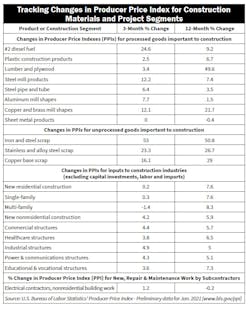Contractors Getting Hammered by Surging Prices for Key Construction Materials
While electrical industry executives are keeping a close eye on soaring copper prices, price increases are a big factor across a broad swath of key building materials. Economists attribute these increases to growing market demand and the slow-but-sure impact of inflation, which had been chugging along at a historically low rate for quite some time.
Home builders are getting hit hardest with these price increases, with lumber prices setting records. According to the U.S. Bureau of Labors Statistics’ (BLS) Producer Price Index (PPI) for construction materials, lumber and plywood pricing are up +49.6% year-over-year (YOY) through January. The National Association of Home Builders (NAHB), Washington, DC, tracks lumber pricing and often advocates for tariff relief on Canadian lumber from Capitol Hill whenever lumber prices start crimping demand for new homes by pushing housing prices past what buyers are willing to spend. One of the most important lumber pricing metrics for the housing market is the Random Lengths Framing Lumber Composite, a weekly measure of lumber prices from the highest volume-producing regions of the U.S. and Canada. NAHB said in a recent post on www.nahb.org that, “Lumber prices have skyrocketed more than +180% since last spring. This price spike has caused the price of an average new single-family home to increase by more than $24,000 since April 17, 2020. NAHB is working with government officials to develop solutions to these sharp price increases which threaten housing affordability across the nation.”
In another post, NAHB said these price increases are “pricing out millions of potential home buyers and impeding the residential construction sector from moving the economy forward.” The association estimates that for every $1,000 increase in the price of an average new home, approximately 154,000 more households would be unable to afford it.
NAHB Chairman Chuck Fowke, a custom home builder from Tampa, FL, said in the post, “NAHB is urging President Biden and Congress to help mitigate this growing threat to housing and the economy by urging domestic lumber producers to ramp up production to ease growing shortages and to make it a priority to end tariffs on Canadian lumber shipments into the U.S. that are exacerbating unprecedented price volatility in the lumber market.”
Associated General Contractors (AGC), Arlington, VA, provides a very helpful monthly summary of trends in construction material pricing in an analysis of the PPI’s construction material data. In its most recent analysis of this BLS data, AGC showed that while copper and lumber had the largest YOY increases, #2 diesel fuel (+9.2%) and plastic construction products (+6.7%) were also tracking much higher on a YOY basis.
Along with NAHB, AGC also supports a review and reduction in trade tariffs for Canadian lumber. AGC said in a recent press release, “Price increases — some to record-setting levels — and long delivery delays are causing hardships for construction firms that are also experiencing challenges in completing projects with crews limited by illness or new work site procedures resulting from the pandemic. Association officials urged the Biden administration to review and rescind a range of trade tariffs in place, including for Canadian lumber, that are contributing to the price increases.”
“The extreme price increases, as reflected in the Producer Price Index report and other sources, are harming contractors on existing projects and making it difficult to bid new work at a profitable level,” said Ken Simonson, the association’s chief economist, in the release. “While contractors have kept bids nearly flat until now, project owners and budget officials should anticipate the prospect that contractors will have to pass along their higher costs in upcoming bids.”
Simonson said the other indicators of the record or historically high prices for construction material include the record set last month by the Framing Lumber Composite Price compiled by the publication Random Lengths mentioned earlier; record levels for several steel product prices; and the fact that copper futures are at an eight-year peak.
There have also been reports of dramatic price YOY increases for Schedule 40 PVC conduit driven in part by rising prices for plastic resins and delays in offshore shipments and domestic production. According to a report at www.theplasticexchange.com, last month’s frigid winter weather shut down 80% to 85% of U.S. domestic resin production, much of which is along the Texas and Louisiana Gulf Coast.
Another indicator pointing toward rising prices for key construction commodities is the price of iron and steel scrap and copper scrap, which always rises when the economy heats up. According to the BLS PPI data for January (see chart on this page), iron and steel scrap is up the most YOY at +50.8%, followed by copper base scrap at +29% YOY, and stainless and alloy steel scrap at +26.7% YOY. Alan Greenspan, former head of the U.S. Federal Reserve, followed steel scrap prices very closely as a gauge of economic activity.
The price increases all eventually find their way into the cost of construction projects, and as you can see in the chart, the BLS’ PPI for key types of residential and nonresidential construction projects have all increased over the past year. Single-family and multi-family construction showed YOY increases through January of +7.6% and +8.3%, respectively, in the PPIs for inputs to construction industries (excluding capital investments, labor and imports). By this measure, healthcare structures saw a YOY increase of +6.5%; commercial structures were up +5.7%; and industrial construction costs increased +5% YOY.

